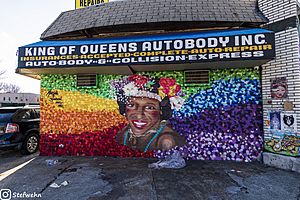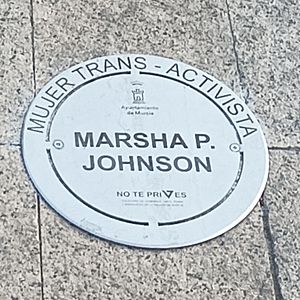Marsha P. Johnson facts for kids
Quick facts for kids
Marsha P. Johnson
|
|
|---|---|
 |
|
| Born |
Malcolm Michaels Jr.
August 24, 1945 Elizabeth, New Jersey, U.S.
|
| Died | July 6, 1992 (aged 46) |
| Known for | Gay liberation and AIDS activist |
Marsha P. Johnson (August 24, 1945 – July 6, 1992), born Malcolm Michaels Jr., was an American activist, an outspoken advocate for gay rights, and a founding member of the Gay Liberation Front (GLF).
In 1970, Johnson alongside close friend Sylvia Rivera established STAR House, a shelter for homeless gay and trans youth.
Johnson was also active in the City's art scene. Beginning in 1987, Johnson was an AIDS activist with ACT UP.
Tributes
- In June 2019, Johnson was one of the inaugural fifty American "pioneers, trailblazers, and heroes" inducted on the National LGBTQ Wall of Honor within the Stonewall National Monument (SNM) in New York City's Stonewall Inn. The SNM is the first U.S. national monument dedicated to LGBTQ rights.
- On June 30, 2020, Google celebrated Marsha P. Johnson with a Google Doodle.
- In August 2020 the Union County, New Jersey Office of LGBTQ Affairs announced Johnson's hometown, Elizabeth, New Jersey, would erect a monument to Johnson. A petition to remove the Christopher Columbus monument and replace it with a statue of Johnson received over 75,000 signatures.
- On August 24, 2020, the 75th anniversary of Johnson's birth, the Marsha P. Johnson State Park was renamed in Johnson's honor, becoming the first New York state park named after an openly LGBT person. Two years later, governor Kathy Hochul announced that a new gate to the park would be constructed in Johnson's honor.
Images for kids
-
Christopher Park in 2013, now part of the Stonewall National Monument, stands across the street from the Stonewall Inn.
See also
 In Spanish: Marsha P. Johnson para niños
In Spanish: Marsha P. Johnson para niños

All content from Kiddle encyclopedia articles (including the article images and facts) can be freely used under Attribution-ShareAlike license, unless stated otherwise. Cite this article:
Marsha P. Johnson Facts for Kids. Kiddle Encyclopedia.





